|
Let’s talk about judging points; the specific things judges look for when they evaluate a quilt. A good place to start is with piecing. Piecing is fairly easy to judge. It’s nice and concrete. You can see (or in some cases, feel) everything about piecing clearly. You can point to specific things that will support your evaluation. Either the point is sharp or it’s not. The seam is straight or it’s not. Piecing judging points are fairly clear-cut, at least at first glance. However there are quite a few of them. You can begin looking at piecing when the quilt is initially held up. While you can’t see anything in detail, you can notice if there is any major distortion or visual distraction that might be traced back to piecing issues. (Or, if we accentuate the positive, you can notice that the quilt seems free of distortion, which might also be traced back to good piecing.) Whatever you see, or don’t see, at this point, be sure to check it out more fully when the quilt is flat on the table. 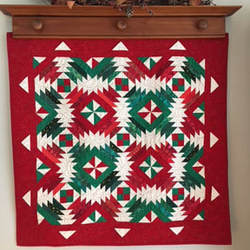 Vertical view of a small pineapple quilt. I would want to take a closer look at the inner borders, especially on the bottom, and the bottom right corner, but on the whole, there are no big red piecing flags. On the most basic evaluative level for piecing, does the quilt design include places where the patches/seams have to meet up? Maybe there isn't much to evaluate. Many clever patterns for blocks, or even the entire quilt top, are designed to be easy to complete without sweating the whole accuracy thing. Or perhaps the pattern limits it to places where the blocks meet but eliminates it within the block, if there is a block at all. A traditional example is the plain log cabin block (although there are variations that do require some meeting seams.) On the modern end of things is improvisational piecing which may or may not retain some block structure. (Of course the real conundrum is figuring out if any inaccuracy was a stylistic choice or lack of skill…. Welcome to quilt judging!) The first, and most basic piecing point is: Do the seams/patches meet accurately? Simple, huh? Maybe not. This is rarely a pure yes or no answer. The judge may very well see more than one degree of accuracy within each quilt, even within each block. Some pieced units are easier to produce than others. A 4 Patch block is less challenging than a 9 Patch, is less challenging than a Pinwheel. 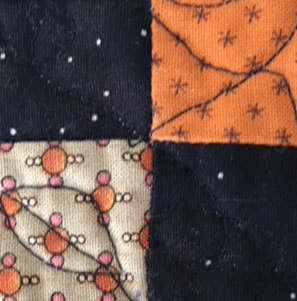 Simple 4 Patch unit. The accuracy of the seam intersections is good. Remember, we are only looking at the intersections now. 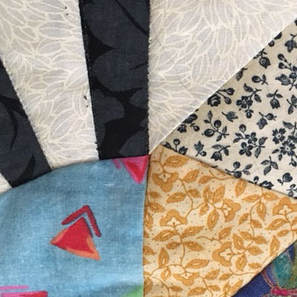 More difficult angles, not as accurately done. 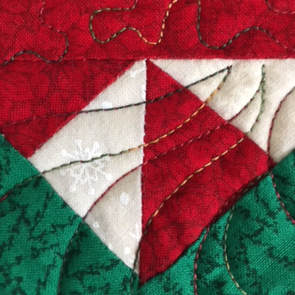 Top angle of half square triangle unit is not perfect but pretty good, especially given that this HST unit is 1 1/4 inches. Lower angle is a little farther off. 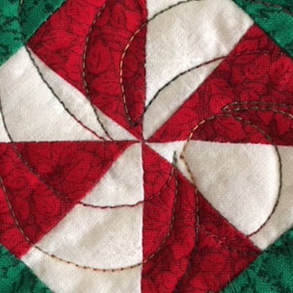 Very clean. High contrast fabrics would make piecing errors highly visible. Some fabrics are easier to work with than others. Some color and value choices hide inaccuracy well and some show every bump and ding. 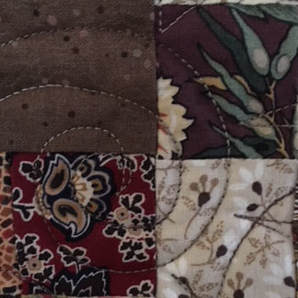 The intersection looks pretty good at first. However, if you look more closely, it's slightly off. The fabrics conceal the issue a little as 3 of the 4 fabrics are white/cream at the point of intersection. Sometimes the quilter will hide or avoid a difficult seam intersection with an embellishment or another ‘design feature.’ 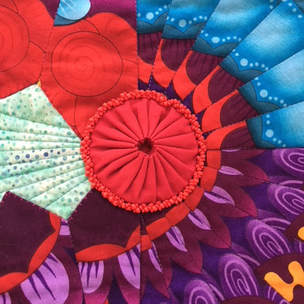 Hmmm...a yo-yo right where 12 fan blades would meet. What do you suppose is under there? The yo-yo above brings up an important judging concept. As a judge, I have no idea what's under there, and the yo-yo and beading are well done. As far as what's in front of the judge, there's not a problem. The judge needs to take it for what it is. The yo-yo strategy will not count against the quilt.....unless, of course, the next quilt in the stack includes 12 fan blades brought together without a yo-yo..... Sometimes the quilting distorts the piecing. If the observed inaccuracy is caused by the quilting, you don’t want to blame the piecing. 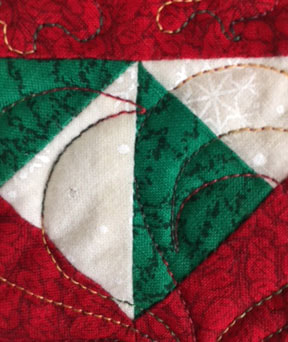 The seam on the lower left edge of the HST unit looks wavy, but it is probably caused by the quilting, not the piecing. And here is a fine but important distinction. As much as the judge might know what the quiltmaker has done to cause the observed inaccuracy, it is not the job of the judge to make teaching comments. The job of the judge is to look at the quilt and fairly evaluate, positive or negative, what the quiltmaker has put in front of them. There is a time and a place for teaching and the judging floor is neither. HOWEVER, it is the job of the judge to know what they are looking at and give accurate feedback to the quiltmaker. If the judge calls the wobbly seam above a piecing error, the entrant is not being given helpful information. We need to get it right.
So let’s put piecing accuracy in the context of quilting competition; and don’t forget, a judged quilt show is, at least on some levels, a contest. In any given group of pieced quilts, there will be quiltmakers who have pulled out all the stops and gone for a high level of difficult. And there will be some quiltmakers who have been more conservative in their choices of skills to demonstrate. Both high- and low-challenge groups with have quiltmakers who have been more successful than others. How do you rank a moderately successful high-challenge piecing job against a very successful low-challenge piecing job? Judges are called upon to make this kind of determination all the time. And while there is no cut and dried answer, there are a few landmarks available to help you navigate your way to the winning quilts. First of all, and mercifully, wins and losses are rarely determined on one feature of a quilt. Piecing does not stand alone. It is surrounded by color and design, fabric choices, all construction methods, quilting design and execution, edge finish etc. etc. The quilt is judged as a whole, as a sum of its parts. The piecing accuracy may be a plus or a minus, but whichever it is, it is in the mix with a whole lot of other pluses and minuses that have just as much influence as the piecing does. (Actually, I’m not sure if that makes judging easier or harder……) Secondly, the judge can only judge what is in front of him/her. You cannot read in or second guess what might have happened if the quiltmaker had made different choices in producing the quilt. It’s like a figure skating competition. The person who does a single jump may, in fact, be able to do a double, but they have not elected to demonstrate that skill. The skater who attempts a triple and does not land it might very well have been able to complete a double, but they risked the more difficult move. The quiltmaker’s choices, made in the execution of the quilt, are theirs. All you can do is judge what they show you, be it 4 Patch or Feathered Star. And that's just one piecing judging point. Hang on, there are lots more! Stacy Koehler, Secretary, NACQJ NQA Certified Judge Qualified to Evaluate Masterpiece Quilts
1 Comment
|
AuthorStacy Koehler became an NQA Certified Judge in 2005. She is a current member of the National Association of Certified Quilt Judges and has served as the new organization's Secretary. She loves quilts and quilters and believes that a well-judged quilt can be a positive influence in its maker's individual development and contribute to the continued growth of the art of quiltmaking. Archives
July 2018
Categories |



 RSS Feed
RSS Feed